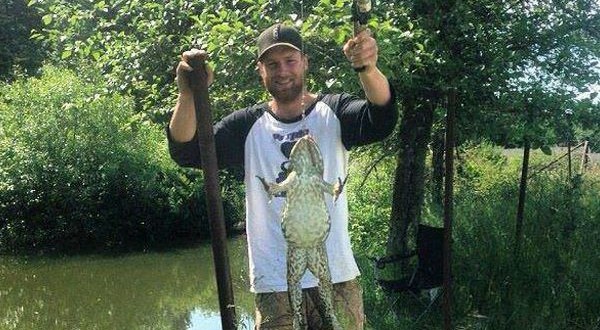This month in the Vancouver Island city of Port Alberni, B.C., carpenter Russ Schut was dangling his line in a muddy pond when he snagged something big: A rabbit-sized, spotted frog whose ribbits are known to sound like the low hum of passing trucks.
“He let it go again because he didn’t know what it was,” said his mother, Lisa Krause.
But as a photo of his catch circulated on a local Facebook page and in the pages of the Alberni Valley Times, it soon became clear Mr. Schut had unwittingly snagged an American bullfrog, a voracious newcomer that is rapidly tearing its way through the Vancouver Island countryside.
Victoria-based bullfrog hunting contractor Stan Orchard explained to the National Post just how bad the frogs are for the community’s biodiversity. “They’re eating salamanders and garter snakes and hatchling turtles … songbirds that come down to the water’s edge to drink, baby ducks, waterfowl … everything that will fit in their mouth,” Orchard said.
The first sighting of the bulls came in 1989 when Orchard, then a herpetologist at the Royal B.C. Museum, was called out to investigate unusually large tadpoles that were spooking swimmers. “They were the size of golf balls with big long tails on them,” he told the newspaper.
Since then the voracious frogs have multiplied unchecked without the presence of any natural predators on the island. The beasts have gotten so bad that Orchard and his company BullfrogControl.com have developed a patented way of killing them. It’s called “electro-frogging” and it involves shocking the water from the safety of an inflatable raft, scooping up the stunned amphibians, and freezing them dead. This method has resulted in Orchard reportedly capturing as many as 300 in fewer than three hours.
That’s a lot of frogs.
Some have spoken up in favor of the frogs, citing how much they love listening to their dulcet croaking. But most agree this invasive species must be controlled.
“We’re wading into a problem that has expanded like a forest fire,” Orchard said. “If you put out a forest fire when it first starts, it’s a much smaller problem than letting it run wild.”
Agencies/Canadajournal
 Canada Journal – News of the World Articles and videos to bring you the biggest Canadian news stories from across the country every day
Canada Journal – News of the World Articles and videos to bring you the biggest Canadian news stories from across the country every day



